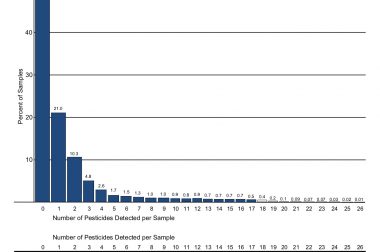Every year the USDA Agricultural Marketing Service’s Pesticide Data Program analyzes a wide variety of food crops and processed foods for pesticide residues. The annual report of testing covering 2018 was recently released (December 2019), with the numbers varying little from recent years. According to the report summary, “Over 99% of the products sampled had residues below Environmental Protection Agency (EPA) tolerances.” Under 1% of samples had pesticide residues above legal limits.
The yearly round of testing sampled a wide variety of domestic and imported foods, with a strong focus on foods that are consumed by infants and children. In 2018, over 10,000 foods were analyzed and 47.8% of those had no detectable pesticides, 21% had one pesticide, and 31.2% of samples had more than one pesticide.
The EPA uses the data for dietary risk assessments and to help make sure pesticide residues in foods remain at safe levels. The USDA uses the data to monitor the relationship of pesticide residues to agricultural practices. In the US, the EPA sets tolerances for pesticides and the Food and Drug Administration (FDA) enforces those tolerances in packaged or processed food products.
Pesticides exceeding the tolerance were detected in 82 samples including:
- 7 samples of asparagus
- 1 sample of cabbage
- 8 samples of cilantro
- 9 samples of heavy cream
- 19 samples of kale
- 1 sample of kiwi fruit
- 3 samples of mangoes
- 3 samples of raisins
- 1 sample of rice
- 4 samples of frozen spinach
- 23 samples of snap peas
- 1 sample of sweet potatoes
- 2 samples of frozen strawberries
Why are pesticides used? Pesticides are used to protect crops against insects, weeds, fungi, and other pests. According to the World Health Organization, pesticides play a significant role in food production. They protect or increase yields and the number of times per year a crop can be grown on the same land. This is particularly important in countries that face food shortages.
What is the risk? None of the pesticides that are authorized for use on food in international trade today are genotoxic (damaging to DNA, which can cause mutations or cancer). Adverse effects from approved pesticides occur above a certain safe level of exposure, which is why tolerance levels have been established for many pesticides. People who face the greatest health risks from exposure to pesticides are those who come into contact with them at work, in their home or garden, or through second-hand exposure. There are a number of pesticides where tolerance levels have not yet been established. In the recent report, 642 samples were found to have pesticides for which no tolerance was established, including 444 fresh fruit and vegetable samples, 151 processed fruit/vegetable samples, 30 rice samples, and 17 wheat flour samples.
What does this mean for consumers? Nearly half of the 10,545 foods analyzed in 2018 (47.8%) had no detectable pesticides; overall, 99% of the foods sampled were within tolerance levels (no or very low levels of pesticide residues). A total of 0.78% or 82 samples had pesticides that exceeded tolerance levels. Foods were sampled from outlets across the U.S. All foods sampled were conventionally grown or from animals raised using standard methods. Results indicate that consumers eating a varied diet can expect to have limited exposure to pesticides from food.
How can consumers limit exposure to pesticides even further? Consumers applying pesticides for work or at home should follow label directions and protect themselves with gloves, protective clothing, and face masks (if necessary). Consumers may be able to further limit their intake of pesticide residues by peeling or washing fruit and vegetables. Although the survey did not analyze foods labeled ‘organic’, choosing foods that are labeled ‘organic’ should further limit pesticide exposure. Ultimately, a varied diet is key to limiting dietary exposure to pesticides and will most benefit low-income households. Stay food-safe!




